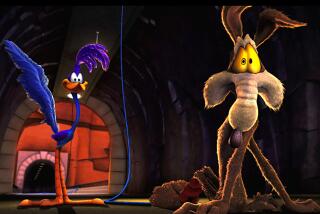A SNEAK PREVIEW OF THE COLORIZATION WARS
- Share via
It was billed as a press conference, but what went on Wednesday in the Mayer Library of the American Film Institute was equal parts news, debate, seminar and sneak preview of the coming war between film makers and the companies engaged in the computer colorization of black and white movies.
The press conference, called by the AFI to announce plans to create a national forum to debate colorizing, heated up when representatives of one of the two colorizing companies attempted to defend the process against charges being leveled at them by a group of angry directors that included Peter Hyams, Stanley Kramer, Martha Coolidge and Nicholas Meyer.
The directors, outraged that such classics as “It’s a Wonderful Life,” “Casablanca” and “The Treasure of the Sierra Madre” have either been artificially colored or are slated for it, condemned the process as an insult to the original creative team and compared it to defacing works of art.
Two executives from Hal Roach Studios, one of the two companies engaged in the thriving new field of computer colorizing, defended themselves on the grounds that only by colorizing old black and white films will people get a chance to see them, and argued that their process actually improves the quality of the original prints.
“We’re giving the viewers an option of discovering these wonderful classics that otherwise they would not get a chance to see and enjoy and experience,” said Rob Word, senior vice president of Hal Roach Studios, a company that specializes in taking films from the public domain and colorizing them.
Word said the economic reality is that there is no TV syndication market for all but a handful of black and white films. By colorizing the others, they are giving the films play time that they would not have.
The directors countered that play time is irrelevant. They said the issue is that the original films were made within the limitations of black and white cinematography, a different form of photography than color, and that by adding colors they are imposing creative decisions on a piece of art that has already been completed.
“Black and white photography is not colored film with the color removed,” said Peter Hyams, who was the cinematographer as well as the director of “2010.” “It is a completely different art form. You physically cannot add color to a black and white photograph and have it be anywhere near what the original photograph was.”
Actor James Stewart, a former AFI life achievement recipient, said that he tried to watch the colorized version of Frank Capra’s “It’s a Wonderful Life” last week and couldn’t get through it all. Stewart, speaking haltingly and with apparent emotion, said his first thought was for Joe Walker, Capra’s longtime cinematographer whose subtle shadings were “wiped out” by the color.
Hal Roach Studios Chairman Earl Glick drew a chorus of boos when he claimed that the studio had actually improved Joe Walker’s work on “It’s a Wonderful Life,” by enhancing areas where Walker’s own photography was faulty.
“It’s a Wonderful Life,” a Christmas perennial, fell out of copyright and into the public domain and was colorized last year by Colorization Inc., a Hal Roach subsidiary. According to Word, the company has already shipped 125,000 cassettes to video stores and TV syndication sales for it are booming.
Colorization Inc., and its competitor, Color Systems Technology, both add color to black and white movies by transferring the films to videotape then using computers to assign colors to shades of gray consistently through each scene. Colorization Inc., works mostly on films taken from the public domain while Color Systems Technology just completed the first of about 150 black and white films that Ted Turner has ordered colorized from his vast MGM library.
The process has already drawn the wrath of a committee of the Directors Guild of America and that organization is expected to adopt a formal stand against it at its national board meeting Oct. 20. On Wednesday, the board of directors of Writers Guild of America, West, added its voice, denouncing colorizing of black and white movies as “an act of cultural vandalism and a distortion of history.”
In a prepared statement, the trustees of the AFI said they are opposed to computer coloring and called it “the ethical responsibility of the copyright holders to protect and preserve the artistic integrity of black and white films.”
AFI Director Jean Firstenberg said the AFI wants to be the catalyst to a dialogue between concerned film professionals and said it would attempt to set up a forum at the institute early next year.
More to Read
Only good movies
Get the Indie Focus newsletter, Mark Olsen's weekly guide to the world of cinema.
You may occasionally receive promotional content from the Los Angeles Times.










